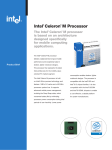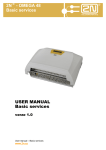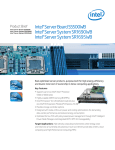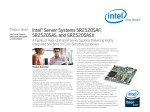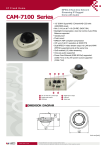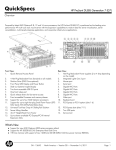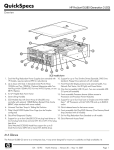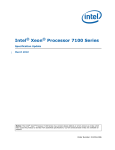Download IBM Dual-Core Intel Xeon 7130N
Transcript
Product Brief Dual-Core Intel® Xeon® Processor 7100 Series Dual-Core Intel® Xeon® Processor 7100 Series Enabling Scalable Performance, Enhanced Virtualization, and Reliable Uptime in Multi-Processor Platforms Intel's dual-core processor, designed specifically for multi-processor server platforms, delivers scalable performance, hardware-assisted virtualization, and reliable uptime for demanding enterprise workloads and business operations. Scalable Performance — 16 MB, Shared, On-die Cache With two 64-bit cores, Hyper-Threading Technology,Δ and up to 16 MB of shared, ondie cache, our latest MP processor enables new levels of scalability and performance: • Up to 60 percent improvement on business processing — enterprise resource planning (ERP), supply chain management (SCM), and customer relationship management (CRM).1 • Up to 70 percent improvement on transaction processing.1 • Over to twice the performance on e-commerce applications.1 • Up to 2.8x performance per watt improvement compared to previous generation.1 • 4 to 32 dual-core processor2 solutions offer headroom for demanding enterprise applications and business growth in traditional and virtual environments. When combined with the Intel® E8501 chipset and DDR2-400 memory, the scalable performance of the Dual-Core Intel® Xeon® processor 71003 series and enhanced reliability features of the chipset and memory create the ideal MP platform for enterprise workloads and virtualization. For more information on performance, please visit www.intel.com/performance/server/xeon 2 Ideal for Virtualization — Intel® Virtualization Technology Scalable performance, added headroom, and enhanced reliability, plus Intel® Virtualization Technology4 built in, enable platforms ideal for virtualization. • Intel Virtualization Technology brings complex software operations encountered in virtual environments into the processor silicon and enables additional new capabilities. • Run Linux* on Windows* and Windows on Xen* on the same platform, giving you added flexibility to optimize your business operations. • Host 64-bit and 32-bit virtual environments. • Intel worked with leading virtualization software vendors, including VMware, Microsoft, and XenSource, to develop Intel Virtualization Technology. Reliable Platform Solutions — Intel® Cache Safe Technology Server platforms built on the Dual-Core Intel Xeon processor 7100 series, Intel E8501 chipset, PCI Express* serial I/O, and DDR2-400 memory technology, offer performance, flexibility, and availability for enterprise applications and the reliability and headroom needed for effective virtualization. • Intel® Cache Safe Technology keeps L3 cache available, even in the event of rare cache failures, reducing expensive downtime and processor replacements. • Intel E8501 chipset reliability features, such as memory (DIMM) sparing, memory mirroring, and enhanced memory error detection and correction capabilities improve uptime and serviceability. • Rich PCI Express reliability features keep I/O available and simplify serviceability. • DDR2-400 memory reduces power consumption and heat generation.5 3 Dual-Core Intel Xeon Processor 7100 Series Overview Feature Benefit Dual-Core Intel® Xeon® processor 71003 series • Up to 2 times the performance of previous-generation Dual-Core Intel® Xeon® processor 7000 series2 • Based on Intel’s 65 nm process with power-saving features for lower energy consumption and heat generation • Up to 2.8x performance per watt improvement compared to previous generation1 • Choice of performance-optimized versions at 150-watt and rack-optimized versions at 95-watt for data center optimization • 64-bit processor, supporting 32-bit applications and enabling migration to 64-bit computing Up to 16 MB, shared, on-die, L3 cache • Keeps more needed data closer to the cores for access faster than off-chip memory • Improves performance by up 60 percent for business processing (ERP, SCM, CRM), 70 percent for transaction processing, and over twice the performance for e-commerce applications1 Intel® Cache Safe Technology • Improves processor reliability • Allows processor and server to continue normal operation in the event of a rare L3 cache error; automatically detects and disables cache lines • Helps reduce downtime and processor replacements, improving TCO Intel® Virtualization Technology4 • Processor enhancements supporting virtualization, enabling consolidation of more applications to virtual environments • Enables 64-bit OSs and applications to run over today’s popular virtualization software • Enables running Linux* over Windows* and Windows over Xen* • Developed with virtualization software providers to enable greater capabilities compared to non-hardware-assisted virtual environments • Intel is first to offer hardware-assisted virtualization Hyper-Threading TechnologyΔ • Allows each core to function as two logical processors • 16 threads for a dual-core, 4 processor (8 cores) platform provide more headroom and throughput capacity for threaded applications • Improves processor utilization and system responsiveness for better user experience6 Intel® 64 Technology7 • Enables extended memory addressability for server applications • Run both 32-bit and 64-bit applications Demand-Based Switching (DBS) with Enhanced Intel SpeedStep® technology8 • Enables platform and software power management features to help lower average power consumption and heat generation while helping to maintain application performance and acoustics High-speed, 3-load, front-side system bus (800 MHz) • 12.8 GB/s system throughput for demanding workloads 4 Server Platform Performance and Performance Per Watt Dual-Core Intel® Xeon® processor 7100 series compared to the prior-generation Dual-Core Intel® Xeon® processor 7000 series Dual-Core Intel® Xeon® processor MP 7140M (3.40 GHz, 16 MB L3) vs. Dual-Core Intel® Xeon® processor MP 7041 (3.00 GHz, 2 x 2 MB L2) e-Commerce 2.82 2.30 Database 1.86 1.70 Relative performance per watt Enterprise Resource Planning Relative performance normalized to Dual-Core Intel® Xeon® processor 7041 1.69 1.60 Intel Xeon Processor MP 7041 Baseline 1.0 0.0 0.5 1.0 1.5 2.0 2.5 3.0 Dual-Core Intel® Xeon® processor MP 7140M (3.40 GHz, 16 MB L3) processor scaling Enterprise Resource Planning 1.92 1.0 e-Commerce 1.88 Dual-Core Intel® Xeon® processor MP 7140M – 4P 1.0 Dual-Core Intel® Xeon® processor MP 7140M – 2P Database 1.85 1.0 0.0 0.5 1.0 1.5 2.0 2.5 3.0 Intel internal measurements as of August 1, 2006. For latest performance information, please visit www.intel.com/performance/server/xeon/index.htm 5 Processor Numbering3 At Intel, our processor series numbers help differentiate processor features beyond front-side bus speed and brand name. New advancements in our processors — other than bus speed — like architecture, cache, power dissipation, and embedded Intel® technologies, contribute significantly to performance, power efficiency, and other end-user benefits. Our processor sequences will help developers decide on the best processor for their platform designs, and help end-users understand all the characteristics that contribute to their overall experience. Processor Sequence 3 Used For Dual-Core Intel® Xeon® processor 3000 sequence Small business, entry, or first server Dual-Core Intel® Xeon® processor 5000 sequence Volume DP servers/workstations based on the Intel Xeon processor Dual-Core Intel® Xeon® processor 7000 sequence Greater scalability than DP platforms with multi-processor enterprise servers Intel® Itanium® 2 processor 9000 sequence Maximum performance and scalability for RISC replacement Dual-Core Intel® Xeon® processor 7100 Series3 All processor packages are FCPGA Socket 604. FSB = 800 MHz 6 Processor Number3 FSB = 667 MHz Power Intel® Cache Safe Technology Intel® HT TechΔ Intel® VT4 Intel® 647 (4P platform) DBS8 2x1M L2, 16M L3 150 W • • • • 8C/16T • 3.33 GHz 2x1M L2, 16M L3 150 W • • • • 8C/16T • 7130N 3.16 GHz 2x1M L2, 8M L3 150 W • • • • 8C/16T • 3.0 GHz 7120N 3.0 GHz 2x1M L2, 4M L3 95 W • • • • 8C/16T 2.60 GHz 7110N 2.50 GHz 2x1M L2, 4M L3 95 W • • • • 8C/16T Speed Processor Number3 Speed NA NA 7150N 3.5 GHz 7140M 3.40 GHz 7140N 7130M 3.20 GHz 7120M 7110M Cache size Cores/ Threads Benchmark notes: Source: Intel® internally measured results as of August 1, 2006. Dual-Core Intel® Xeon® Processor 7100 series: Performance and Performance Per Watt plus Server Platform Scaling Basis for comparison: Performance measured using internal server-side Java* (“e-commerce”), internal database transaction processing, and internal enterprise resource planning workloads. Intel internal measurement (1 August 2006) comparing system configurations of 4x Intel® processor 7140M platform, 3.40 GHz w/ 16M L3/ Intel® E8501Chipset / 800 MHz FSB to 4x Intel® Xeon® Dual-Core processors 3.00 GHz w/ 2x2M L2 / Intel® E8501Chipset/ 800 MHz FSB. Scaling performance measuring performance gains of one to two to four Intel Xeon processor(s) MP 7140M configured in an 4P Intel E8501 chipset-based Server platform. Actual performance may vary. For further information see: http://www.intel.com/performance/server/xeon_mp/index.htm Server-Side Java Application. This workload evaluates the performance of Server-side Java Application. Measured in Operations Per Second. Performance estimates based on Intel internal measurement recorded in TR#622. Baseline Platform configuration: Intel® Server System pre-production hardware with four Dual-Core Intel® Xeon® Processors 7041, 3.0 GHz with 2x2MB L2 Cache, E8501 Chipset, 800 MHz FSB; 16 GB memory; Hyper Threading ON; Windows* 2003 Enterprise Edition x64 SP1, BEA* Internal JRockit* 5.0 64-bit, large page enabled, Hardware Prefetch / Adjacent Sector Prefetch = OFF, 4 JVM instances. New Platform Configuration: Intel® Server System pre-production hardware with four Dual-Core Intel® Xeon® Processor MP 3.40 GHz with 16 MB L3 Cache, E8501 Chipset, 800 MHz FSB; 16 GB memory; Hyper Threading ON; Windows* 2003 Enterprise Edition x64 SP1, BEA* Internal JRockit* 5.0 64-bit, large page enabled, Hardware Prefetch = OFF, Adjacent Sector Prefetch = ON, 4 JVM instances. Database. On-Line Transaction Processing; represents the transaction throughput of a database server in an OLTP client/server environment measuring the power and capacity of database software and server hardware in transactions per minute. Performance estimates based on Intel internal measurement recorded in TR#579. Baseline Platform Configuration: Intel® SR6850HW4/M Server System using 4x Dual-Core Intel® Xeon® processor MP 7041 (3.00 GHz, 800 MHz FSB, 2x 2 MB L2 cache), HW/ADJSECT PREFETCH=OFF, 64GB DDR2-400 (16x 4 GB PC23200R-333), Microsoft* Windows* Server 2003 Enterprise Edition SP1 x64, Microsoft* SQL Server* 2005 SP1(64-bit). Storage Configuration – 854 15K RPM Seagate SCSI disks – 4 QLE2362 PCI-E QLogic Dual-port adapters – 1 QLA2342 PCI-X QLogic Dual-port adapters New Platform configuration: Intel® SR6850HW4/M Server System (Harwich with 800MT/s) using 4x Dual-Core Intel® Xeon® processor MP 7140M (3.40 GHz, 800 MHz FSB, 16 MB L3 cache), HW/ADJSECT PREFETCH=OFF, 64GB DDR2-400 (16x4GB PC2-3200R-333), Microsoft* Windows* Server 2003 Enterprise Edition SP1 x64, Microsoft* SQL Server* 2005 SP1(64-bit). Storage Configuration – 994 15K RPM Seagate SCSI disks – 3 QLA 2342 PCI-X QLogic Dual-port adapters – 4 QLA 2362 PCI-E QLogic Dual-port adapters Enterprise Resource Planning. Workload emulates a SAP-based Sales and Distribution application and helps ERP. Measured in number of concurrent users supported. Performance estimates based on Intel internal measurement recorded in TR# 573. Baseline Platform Configuration: Intel® S3E3134 Server System using 4x Dual-Core Intel® Xeon® processor MP 7041 (3.00 GHz, 800 MHz FSB, 2x 2 MB L2 cache), HW/ADJSECT PREFETCH=ON, 32GB DDR2-400 (16x2 GB PC2-3200R), SuSE* LINUX* Enterprise 9 x86_64 SP2 2.6.5-191-smp, SAP* R/3 Enterprise ECC4.7 SR1 x86_64, Oracle9i* Enterprise Edition release 9.2.0.6.0 64-bit. New Platform configuration: Intel® S3E3134 Server System using 4x Dual-Core Intel® Xeon® processor 7140M (3.40 GHz, 800 MHz FSB, 16 MB L3 cache), HW/ADJSECT PREFETCH=OFF, 8GB DDR2-400 (8x1GB PC2-3200R), SuSE* LINUX* Enterprise 9 x86_64 SP2 2.6.5-191-smp, SAP* R/3 Enterprise ECC5.0 SR1 x86_64, Oracle9i* Enterprise Edition release 9.2.0.6.0 64-bit. Performance Per Watt is calculated as peak performance result divided by watts measured at the system level. All system watt measurements may vary based on system configuration and silicon-level differences. Any difference in system hardware or software design or configuration may affect actual performance. Buyers should consult other sources of information to evaluate the performance of systems or components they are considering purchasing. For more information on performance tests and on the performance of Intel products, visit http://www.intel.com/performance/resources/limits.htm or call (U.S.) 1-800-628-8686 or 1-916-356-3104. All dates and products specified are for planning purposes only and are subject to change without notice. Relative performance for each benchmark is calculated by taking the actual benchmark result for the first platform tested and assigning it a value of 1.0 as a baseline. Relative performance for the remaining platforms tested was calculated by dividing the actual benchmark result for the baseline platform into each of the specific benchmark results of each of the other platforms and assigning them a relative performance number that correlates with the performance improvements reported. Find out more about Dual-Core Intel Xeon processors at www.intel.com/server 7 www.intel.com/server Contacts United States and Canada Intel Corporation Robert Noyce Building 2200 Mission College Blvd. P.O. Box 58119 Santa Clara, CA 95052-8119 USA Europe Intel Corporation (UK) Ltd. Pipers Way Swindon Wiltshire SN3 1RJ UK Asia-Pacific Intel Semiconductor Ltd. 32/F Two Pacific Place 88 Queensway, Central Hong Kong, SAR South America Intel Semiconductores do Brasil LTDA Av. Dr. Chucri Zaidan, 940-10° andar 04583-904 São Paulo, SP Brazil Japan Intel Japan (Tsukuba HQ) 5-6 Tokodai Tsukuba-shi 300-2635 Ibaraki-ken Japan 1 Based on internal Intel benchmarks. See benchmarks page. 2 Intel platforms based on the Intel® E8501 chipset scale to 4 processors. Other OEMs offer scalable platforms to 32 processors. 3 Intel processor numbers are not a measure of performance. Processor numbers differentiate features within each processor family, not across different processor families. See http://www.intel.com/products/processor_number for details. 4 Intel® Virtualization Technology requires a computer system with a processor, chipset, BIOS, virtual machine monitor (VMM) and applications enabled for virtualization technology. Functionality, performance or other virtualization technology benefits will vary depending on hardware and software configurations. Virtualization technology-enabled BIOS and VMM applications are currently in development. 5 Based on Intel power testing utilizing Intel® Xeon® processor 3.66 GHz with 667 MHz system bus. Dual-Core Intel Xeon Processor 7XXX expected to exhibit similar power consumption characteristics. Actual power savings will vary based on system configuration and workloads. 6 Source: http://www.intel.com/technology/computing/htt/index.htm 7 64-bit computing on Intel architecture requires a computer system with a processor, chipset, BIOS, operating system, device drivers and applications enabled for Intel® 64 architecture. Processors will not operate (including 32-bit operation) without an Intel® 64 architecture-enabled BIOS. Performance will vary depending on your hardware and software configurations. Consult with your system vendor for more information. 8 Demand-based switching is not available on 95 watt SKUs. Δ Hyper-Threading Technology requires a computer system with an Intel® Xeon® processor supporting Hyper-Threading Technology and an HT Technology-enabled chipset, BIOS and operating system. Performance will vary depending on the specific hardware and software you use. See http://www.intel.com/info/hyperthreading/ for more information including details on which processors support HT Technology. Information in this document is provided in connection with Intel products. No license, express or implied, by estoppel or otherwise, to any intellectual property rights is granted by this document. Except as provided in Intel’s Terms and Conditions of Sale for such products, Intel assumes no liability whatsoever, and Intel disclaims any express or implied warranty, relating to sale and/or use of Intel products including liability or warranties relating to fitness for a particular purpose, merchantability or infringement of any patent, copyright, or other intellectual property right. Intel products are not intended for use in medical, life-saving or life-sustaining applications. Intel may make changes to specifications and product descriptions at any time, without notice. Designers must not rely on the absence or characteristics of any features or instructions marked “reserved” or “undefined.” Intel reserves these for future definition and shall have no responsibility whatsoever for conflicts or incompatibilities arising from future changes to them. *Other brands and names may be claimed as the property of others. Copyright © 2006 Intel Corporation. All rights reserved. Intel, the Intel logo, Intel. Leap ahead., Intel. Leap ahead. logo, Intel Xeon, Intel SpeedStep, Intel Itanium, and the Intel inside logo are trademarks or registered trademarks of Intel Corporation or its subsidiaries in the United States and other countries. Printed in USA 0906/TJH/OCG/XX/PDF Please Recycle 309983-004US








